Are you months (or even years) past having your most recent baby, but you still look pregnant?
Or even if you’ve never had a baby, you have a pooch at your belly that won’t go down.
You’ve tried dieting, you’ve tried ab workouts, or maybe you’ve just given up. Even if the rest of your body looks fairly fit, your belly just hasn’t budged.
You might be living with diastasis recti. Read on to learn more about this condition!
Disclosure: This article contains affiliate links. As an Amazon associate I earn from qualifying purchases. You can read my full policy here.
I am not a medical doctor. I’m simply sharing my experience. Please discuss your condition with your own health care provider or find a physical therapist for help if you suspect you have diastasis recti.
Table of Contents
My experience with diastasis recti
About two and a half years ago, I was at an obligatory social function, but having a nice enough time. I sat down with some people, made pleasant small talk, and sat through a presentation. You know, the usual.
Afterwards, the man beside me turned and said, “Now, I know you’re never supposed to ask this of a woman…”
I turned and brightly said, “Yes?” I had no clue what was coming.
“…But how far along are you?”
Ah. That.
You could see the other people at the table, who already knew me, stop like they were witnessing a train wreck. I plastered a smile on my face and said, “Actually, I’m twelve weeks postpartum after my third child.”
Now, if this were me who had mistakenly called a woman pregnant, I’d think the appropriate response would be to apologize profusely. But not this, erm, gentleman.
He laughed and said, “I would have guessed five months! I was an EMT,” as if that training somehow made him an expert in women’s size during pregnancy.
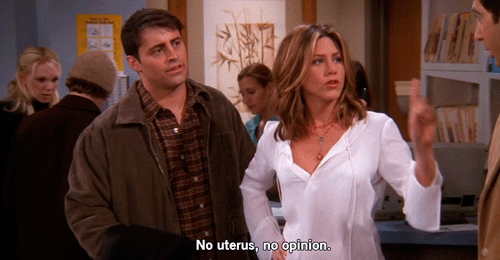
I ended up laughing it off because that reaction seemed preferable to curling into a ball and crying in public (Besides, despite what you see on the internet, it’s totally normal and healthy to not have sprung back to pre-baby shape within twelve weeks).
Over the next several months, I kept getting these comments (what’s with people, anyways?). I wanted to know why my shape wasn’t getting better, so I started looking for answers.
What is diastasis recti?
I started doing some research and found that women who have gone through pregnancy can end up with a condition called diastasis recti, in which the connective tissue (the linea alba) between the “six pack muscles” of your abdomen (or the rectus abdominis) become separated down the middle.
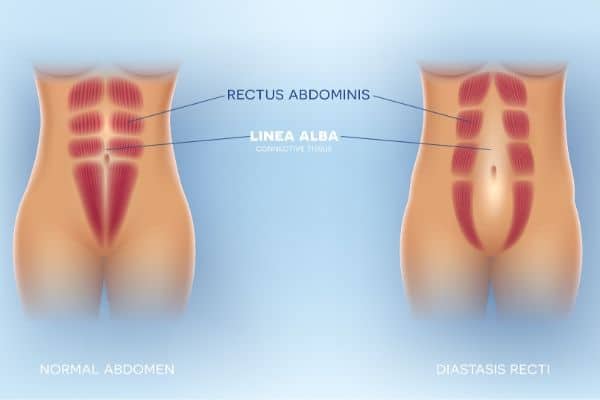
This condition can cause your tummy to look, um, not particularly tight. Even if everything else is in shape, you’ll still have a “mom pooch” (I’m not personally a fan of the term, but you know what I mean).
And even though people call this a “mom pooch,” you don’t have to have been pregnant for it to happen. Excessive weight gain (even after you’ve lost the weight) or incorrect exercises can both cause separation of the linea alba.
Diastasis recti can affect more than just your appearance. This problem can be related to pelvic floor issues, bladder control, lower back pain, and even affect your day-to-day functioning if it’s severe enough.
Unfortunately, day-to-day activities with a new baby can delay healing of diastasis recti. Twisting at your midsection, sitting with poor posture while feeding your baby, even getting up from lying down incorrectly can all further damage your core.
RELATED: How to comfortably breastfeed your baby – advice from a physical therapist
The next time I went to my doctor I asked him about the possibility of me having an abdominal separation. He felt my belly and said he didn’t think there was anything wrong.
Despite what he said, I wasn’t convinced, so I kept searching.
As I googled, I saw that everyone had a product or program to fix the diastasis. I asked the nurse at my gyno’s office, and she said to just do some crunches and I’d be fine (bad idea, by the way, based on what you need to heal an abdominal separation).
(Spoiler alert: your PCP or even your OB/midwife may not have training in identifying diastasis recti. Check with someone trained in recognizing this condition, such as a PT with expertise in women’s health.)
I tried some alternative abdominal exercises that helped some (at least I think), but I couldn’t really measure my progress, so it was hard to tell. After a while I sort of gave up and decided this was my lot in life.
Do you have diastasis recti?
Why did it take so long for me to find out that physical therapy was an option? After all, I Googled all about diastasis recti! Lots of people were excited to sell splints or belly binders, but no one mentioned that PT could help.
And while I’m glad I finally found someone who could get me the treatment I needed, it’s crazy that it took going to my yoga instructor instead of my doctor or gynecologist to get some answers. This is a women’s health issue, people.
If you haven’t found someone to help you yet, you can do a self check for diastasic recti. Follow this link to learn how to self-check for DR..
Why traditional abdominal exercises don’t help with abdominal separation
Just like the nurse told me when I asked about diastasis recti, less informed people will just tell you, “Oh, do some pilates or crunches! That’ll fix it.”
Or perhaps they’ll suggest you do planks until you can hold them for a minute at a time.
These are all terrible suggestions for fixing diastasis recti. In fact, they’re likely to make your ab separation worse.
Think about an abdominal separation like the one shown below.
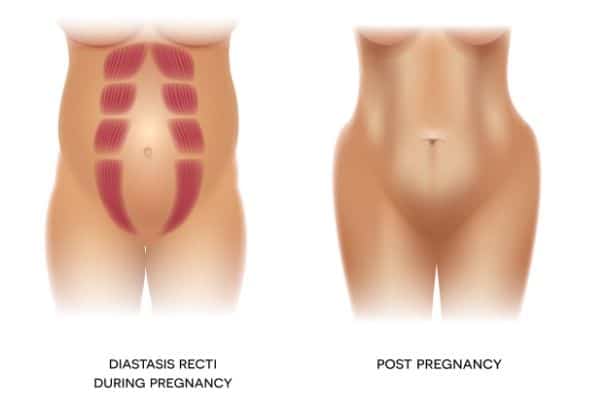
What’s going to happen when you do crunches with that separation? Just like if you held a belt in half and pushed the two ends together, the opening between the muscles will separate further.
Crunches, planks, and even exercises in table pose can cause the rectus abdominis to gape open, making the separation even worse. So you need to choose abdominal and pelvic exercises that don’t allow this gaping.
In addition, you need to strengthen the transverse abdominis, the muscles that wrap all the way around from the back to the front of your core horizontally.
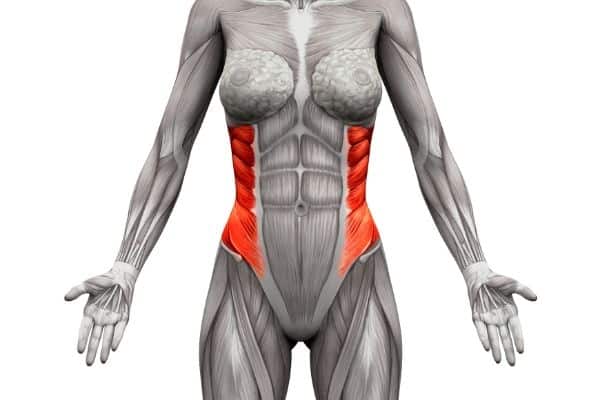
These muscles help support your weakened core. Once they are strengthened, you can continue to work (carefully!) towards healing the separation at the linea alba.
Should you use a belly band for diastasis recti?
There’s conflicting advice on whether to use a belly band or waist-trainer for diastasis recti. Nay-sayers will tell you that using a belly band will make your core even weaker by making you reliant on the extra support.
But if you use a belly band correctly, it can be helpful. When you are very first postpartum and you feel like you have zero support in your abdominal area, a belly band can help support your back. In addition, it can help bring the two sides of your rectus abdominis closer together so they are able to heal back together. And if your PT instructs you to do supported crunches (where you use your hands to physically hold the two sides of your stomach together), a belly band can help.
What you don’t want to do, though, is use a postpartum girdle as a “waist trainer.” First of all, that’s just not how it works. Secondly, if you are wrapping a belly band around your middle as tight as you can, you may feel additional pressure in your pelvis. That pressure comes from your organs and can lead to or worsen pelvic prolapse, which is not something you want to deal with. So don’t use a band that way.
Best belly bands for diastasis recti
Remember, a belly binder for diastasis is just there to hold your “six pack muscles” closer together so they can stitch back together. It’s not going to look like the models you see with tiny waists. You’re not supposed to!

If you want a binder that is designed specifically for closing diastasis, try out the rehab splint from Tupler Technique. It’s design is different from anything I’ve seen anywhere else, and it reminds me of the taping techniques my PT uses. (Note: If you have a longer torso, you might need two splints, either a regular length and a short torso one, or two regular length ones. It just depends on your body shape).
But if you prefer a cheaper one, you can find one on Amazon. You just have to be careful that you don’t get one that’s bad quality.
I like this one for a few reasons. First of all, it wraps and velcros around, so you don’t have to worry about pulling it all the way up your legs and over your hips. Secondly, the waist belt and pelvic belt give you support where you need it most.
K Tape for diastasis recti
Each week, my PT used kinesio tape on my abdomen. K Tape is basically a tape that stretches longways but not horizontally. It lasts for a few days, even with showering, and it’s really helpful.
K tape helped gently hold my skin and muscles together so they could heal. If the kinesio tape came loose during the week, I would retape myself with tape I bought myself.
Note: Some people’s skin is sensitive to the adhesive used in K Tape. When you remove it, do so slowly and a little at a time. Do NOT rip it off like a Band-Aid, or you will be sorry.
Healing stretch marks and tightening skin after diastasis recti
I asked my PT if my skin over my belly would ever tighten up too. Actually, what I asked was, “Will I have a belly button again?” I’m not gonna lie, I miss my pre-pregnancy belly button.
Her answer was not to get my hopes up too much about the belly button, but I could definitely tighten my skin.
She recommended liquid Vitamin E to apply directly to my belly, as well as collagen supplements to help rebuild my skin.
While things aren’t exactly the same as before children, and I have no expectation that they will ever be, the two supplements have definitely improved the skin tone of my belly!
Who can help with diastasis recti?
Almost a year after I’d initially given up on getting core back in shape, I went to my yoga class and asked my terrific instructor her opinion.
She palpated my abdomen a little and told me that, although she wasn’t an expert, she thought that I may indeed have diastasis recti. She then recommended a local physical therapist.
I didn’t even realize physical therapy was an option! I was excited to go.
If there’s not a reputable PT for Women’s Health in your area or you just want to deal with the problem from home, check out The Tupler Technique. Their program is evidence-based and shown to heal diastasis recti.
Physical therapy for diastasis recti
I went for an intake at the physical therapy office, and I was told that I had a 15 cm (6 in) diastasis that was at least 2 fingers wide. While I was disappointed to find out, it was also a relief to have someone confirm what I had suspected for almost a year and a half.
To treat the problem, I started with simple abdominal exercises (Repeat after me: Not crunches or planks) and went weekly, building up what I could as I practiced from home.
I did physical therapy for about four months. In that time, my separation narrowed considerably to only about 2.5 cm now (pretty much only right under my belly button)!
UPDATE: After a fourth child, my separation increased again, and it was all the way from my pubic bone up to my rib cage. I did physical therapy to close it some, but I unfortunately also developed an umbilical hernia. The only way to repair a hernia is through surgery, so I chose to have both the hernia and the diastasis repaired via a tummy tuck. You can read more about my experience here.
My abdominal region wasn’t perfect, but it’s definitely better than it was before. Actually, I told my husband this was the strongest my ab muscles have been in about a decade!
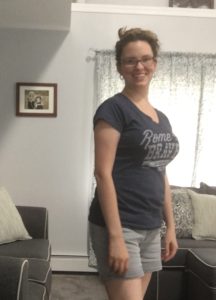
How to get physical therapy for diastasis recti covered by insurance
Generally speaking (at least here in the States), insurance will cover PT for a month without a script from your doctor. Once I had a script sent in to my doctor (the same one who told me I was fine), he signed off, no problem, and I was able to continue to go to PT.
It was really encouraging to be able to go in weekly and actually track my progress. There were some weeks where the length of the separation didn’t change, but it still narrowed over that time.
Atlas physical therapy in Central PA
If you happen to be in Central PA, may I strongly suggest the physical therapists who helped me? I went to Atlas Physical Therapy in Altoona, and they have a fantastic staff! Holly Strobel, my PT, focuses specifically on women’s health issues, so she knew exactly what exercises would work for me, and what I should avoid, such as crunches, deep twists, and anything up on all fours.
In addition, Atlas can treat all sorts of women’s health issues related to maternal health! Anything from mastitis and clogged milk ducts to C-section scars; they’re on it.
Plus, Atlas has another location in State College, so if you’re over near Penn State, check them out over there instead! (Btw, I don’t get anything by linking to Atlas or if you find them through me; I’m just that excited about how they’ve helped me!).
Conclusions on living with diastasis recti
Living your life with DR can be hard, from self confidence issues about appearance to lower back pain. But with help, it can get better!
But most importantly, I hope you’re cherishing your time with the little one who changed not just the shape of your body, but your whole life.



This is great! I am pretty sure I have diastasis recti, but I also never thought to look into PT to help. Doctors have also told me that all my postpartum issues are fine and normal. I also still have extreme sensitivity and sometimes pain around my C-section scar. Yup, tooootttallly normal, nothing to do about it. Because it’s just woman pain. Ugh!
Yeah, definitely go see someone. Here in PA you don’t have to have a script from your doctor for the first month of treatment, and it’ll be covered through your insurance. And seriously, Holly at Atlas Therapy is great!
Thankyou for helping out, wonderful info .
Thank you so much this post! It’s so encouraging to know that there is something I can do about my stomach.
You’re so welcome Balle! Glad to help.
Hi!
How much did you repair your Diastis Recti before getting pregnant again? We’re starting to plan baby #2 and I wonder how much I should or need to repair prior to trying again. I haven’t had mine looked at yet, but plan to soon.
Hi Anna! Honestly, between babies 1, 2, and 3 I was totally oblivious to the possibility of DR, so it wasn’t until after baby #3 that I did anything. I had mine down to nearly totally repaired and then ended up pregnant again lol. But the nice thing is after baby #4, I already had a smaller separation at 6 weeks postpartum than I did over a year after baby #3.
I think the real value of working on it before another baby is the mind-body connection and awareness. I was aware of my core and what moves I shouldn’t make to avoid damage. I knew how to engage my transverse abdominis, so I had a head start the next time around.
I’m not pregnant. Haven’t been for 21 years. I have the cone shaped belly. If I lie flat and tighten to get up there is a nice big cone shape towards the top of my belly. Went to my PCP and he said nothing can be done. I’m on my weight loss journey (started 09/01/20). Apparently does t. After how much weight I lose it’ll still be there. I live in MD. Who can I talk to, to get this to go away or at least get smaller? Thx.
Hi Debbie, google physical therapists in your region who specialize in women’s health or pelvic floor issues. Don’t do crunches or planks. Practice exhaling while drawing in your core muscles gently. Sometimes just that breathing work did more to close my gap than ab exercises. Congrats on the weight loss journey and good luck!
Hi! I have been researching this issue for ever, thank you for posting. I have had a “potbelly” my whole life, pre-kids and now post kids. I used to push my stomach out as a kid all the time making it look like I was pregnant. I also have bad posture that I’m working on. No matter what I do- planks, and lower ab workouts included, nothing seems to work. I thought this must just be my body type but with this article I’m hopeful there is something I can do. I am fairly fit everywhere else but my dang lower stomach. Should I try to seek PT help to see if I do have DT? Thank you again!
Hi Diamond,
You’re so welcome! Glad this helps. Definitely stop doing the planks and crunches. And yes, go check with a PT and see what they think. Good luck!